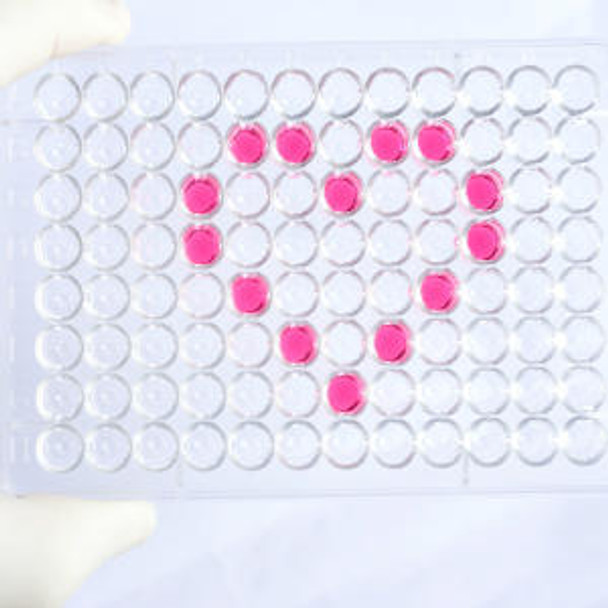Human TGF-beta receptor type-2 (TGFBR2) ELISA Kit
- SKU:
- HUEB2721
- Product Type:
- ELISA Kit
- Size:
- 96 Assays
- Uniprot:
- P37173
- Range:
- 0.156-10 ng/mL
- ELISA Type:
- Sandwich
- Synonyms:
- TGFBR2, TGF-beta receptor type-2, TGFR-2
- Reactivity:
- Human
Description
| Product Name: | Human TGF-beta receptor type-2 (TGFBR2) ELISA Kit |
| Product Code: | HUEB2721 |
| Alias: | TGF-beta receptor type-2, TGFR-2, TGF-beta type II receptor, Transforming growth factor-beta receptor type II, TGF-beta receptor type II, TbetaR-II, TGFBR2, 2.7.11.30 |
| Uniprot: | P37173 |
| Reactivity: | Human |
| Range: | 0.156-10 ng/mL |
| Detection Method: | Sandwich |
| Size: | 96 Assay |
| Storage: | Please see kit components below for exact storage details |
| Note: | For research use only |
| UniProt Protein Function: | TGFBR2: a TKL kinase of the serine/threonine-protein kinase receptor (STKR) family. R1 and R2 TGF-beta receptors dimerize after binding TGF-beta at the cell surface. Binds to DAXX. Defects can cause esophageal cancer. |
| UniProt Protein Details: | Protein type:Oncoprotein; Membrane protein, integral; Protein kinase, TKL; EC 2.7.11.30; Protein kinase, Ser/Thr (receptor); Kinase, protein; TKL group; STKR family; Type2 subfamily Chromosomal Location of Human Ortholog: 3p22 Cellular Component: caveola; cytosol; external side of plasma membrane; integral to membrane; lipid raft; plasma membrane; receptor complex Molecular Function:ATP binding; glycosaminoglycan binding; metal ion binding; mitogen-activated protein kinase kinase kinase binding; protein binding; receptor signaling protein serine/threonine kinase activity; SMAD binding; transforming growth factor beta binding; transforming growth factor beta receptor activity; transforming growth factor beta receptor activity, type II; transmembrane receptor protein serine/threonine kinase activity Biological Process: activation of protein kinase activity; aging; apoptosis; blood vessel development; brain development; common-partner SMAD protein phosphorylation; embryo implantation; embryonic cranial skeleton morphogenesis; embryonic hemopoiesis; gastrulation; gut development; heart development; in utero embryonic development; lens development in camera-type eye; myeloid dendritic cell differentiation; negative regulation of cardiac muscle cell proliferation; negative regulation of transforming growth factor beta receptor signaling pathway; Notch signaling pathway; organ regeneration; palate development; patterning of blood vessels; peptidyl-serine phosphorylation; peptidyl-threonine phosphorylation; positive regulation of angiogenesis; positive regulation of B cell tolerance induction; positive regulation of cell proliferation; positive regulation of mesenchymal cell proliferation; positive regulation of NK T cell differentiation; positive regulation of skeletal muscle regeneration; positive regulation of smooth muscle cell proliferation; positive regulation of T cell tolerance induction; positive regulation of tolerance induction to self antigen; protein amino acid phosphorylation; receptor-mediated endocytosis; regulation of cell proliferation; regulation of gene expression; response to drug; response to estrogen stimulus; response to glucose stimulus; response to mechanical stimulus; response to nutrient; smoothened signaling pathway; transforming growth factor beta receptor signaling pathway; vasculogenesis; wound healing Disease: Colorectal Cancer, Hereditary Nonpolyposis, Type 6; Esophageal Cancer; Loeys-dietz Syndrome 2 |
| NCBI Summary: | This gene encodes a member of the Ser/Thr protein kinase family and the TGFB receptor subfamily. The encoded protein is a transmembrane protein that has a protein kinase domain, forms a heterodimeric complex with another receptor protein, and binds TGF-beta. This receptor/ligand complex phosphorylates proteins, which then enter the nucleus and regulate the transcription of a subset of genes related to cell proliferation. Mutations in this gene have been associated with Marfan Syndrome, Loeys-Deitz Aortic Aneurysm Syndrome, and the development of various types of tumors. Alternatively spliced transcript variants encoding different isoforms have been characterized. [provided by RefSeq, Jul 2008] |
| UniProt Code: | P37173 |
| NCBI GenInfo Identifier: | 116242818 |
| NCBI Gene ID: | 7048 |
| NCBI Accession: | P37173.2 |
| UniProt Secondary Accession: | P37173,Q15580, Q6DKT6, Q99474, B4DTV5, |
| UniProt Related Accession: | P37173 |
| Molecular Weight: | 67,457 Da |
| NCBI Full Name: | TGF-beta receptor type-2 |
| NCBI Synonym Full Names: | transforming growth factor beta receptor II |
| NCBI Official Symbol: | TGFBR2 |
| NCBI Official Synonym Symbols: | AAT3; FAA3; LDS2; MFS2; RIIC; LDS1B; LDS2B; TAAD2; TGFR-2; TGFbeta-RII |
| NCBI Protein Information: | TGF-beta receptor type-2 |
| UniProt Protein Name: | TGF-beta receptor type-2 |
| UniProt Synonym Protein Names: | TGF-beta type II receptor; Transforming growth factor-beta receptor type II; TGF-beta receptor type II; TbetaR-II |
| Protein Family: | TGF-beta receptor |
| UniProt Gene Name: | TGFBR2 |
| UniProt Entry Name: | TGFR2_HUMAN |
| Component | Quantity (96 Assays) | Storage |
| ELISA Microplate (Dismountable) | 8×12 strips | -20°C |
| Lyophilized Standard | 2 | -20°C |
| Sample Diluent | 20ml | -20°C |
| Assay Diluent A | 10mL | -20°C |
| Assay Diluent B | 10mL | -20°C |
| Detection Reagent A | 120µL | -20°C |
| Detection Reagent B | 120µL | -20°C |
| Wash Buffer | 30mL | 4°C |
| Substrate | 10mL | 4°C |
| Stop Solution | 10mL | 4°C |
| Plate Sealer | 5 | - |
Other materials and equipment required:
- Microplate reader with 450 nm wavelength filter
- Multichannel Pipette, Pipette, microcentrifuge tubes and disposable pipette tips
- Incubator
- Deionized or distilled water
- Absorbent paper
- Buffer resevoir
*Note: The below protocol is a sample protocol. Protocols are specific to each batch/lot. For the correct instructions please follow the protocol included in your kit.
Allow all reagents to reach room temperature (Please do not dissolve the reagents at 37°C directly). All the reagents should be mixed thoroughly by gently swirling before pipetting. Avoid foaming. Keep appropriate numbers of strips for 1 experiment and remove extra strips from microtiter plate. Removed strips should be resealed and stored at -20°C until the kits expiry date. Prepare all reagents, working standards and samples as directed in the previous sections. Please predict the concentration before assaying. If values for these are not within the range of the standard curve, users must determine the optimal sample dilutions for their experiments. We recommend running all samples in duplicate.
| Step | |
| 1. | Add Sample: Add 100µL of Standard, Blank, or Sample per well. The blank well is added with Sample diluent. Solutions are added to the bottom of micro ELISA plate well, avoid inside wall touching and foaming as possible. Mix it gently. Cover the plate with sealer we provided. Incubate for 120 minutes at 37°C. |
| 2. | Remove the liquid from each well, don't wash. Add 100µL of Detection Reagent A working solution to each well. Cover with the Plate sealer. Gently tap the plate to ensure thorough mixing. Incubate for 1 hour at 37°C. Note: if Detection Reagent A appears cloudy warm to room temperature until solution is uniform. |
| 3. | Aspirate each well and wash, repeating the process three times. Wash by filling each well with Wash Buffer (approximately 400µL) (a squirt bottle, multi-channel pipette,manifold dispenser or automated washer are needed). Complete removal of liquid at each step is essential. After the last wash, completely remove remaining Wash Buffer by aspirating or decanting. Invert the plate and pat it against thick clean absorbent paper. |
| 4. | Add 100µL of Detection Reagent B working solution to each well. Cover with the Plate sealer. Incubate for 60 minutes at 37°C. |
| 5. | Repeat the wash process for five times as conducted in step 3. |
| 6. | Add 90µL of Substrate Solution to each well. Cover with a new Plate sealer and incubate for 10-20 minutes at 37°C. Protect the plate from light. The reaction time can be shortened or extended according to the actual color change, but this should not exceed more than 30 minutes. When apparent gradient appears in standard wells, user should terminatethe reaction. |
| 7. | Add 50µL of Stop Solution to each well. If color change does not appear uniform, gently tap the plate to ensure thorough mixing. |
| 8. | Determine the optical density (OD value) of each well at once, using a micro-plate reader set to 450 nm. User should open the micro-plate reader in advance, preheat the instrument, and set the testing parameters. |
| 9. | After experiment, store all reagents according to the specified storage temperature respectively until their expiry. |
When carrying out an ELISA assay it is important to prepare your samples in order to achieve the best possible results. Below we have a list of procedures for the preparation of samples for different sample types.
| Sample Type | Protocol |
| Serum | If using serum separator tubes, allow samples to clot for 30 minutes at room temperature. Centrifuge for 10 minutes at 1,000x g. Collect the serum fraction and assay promptly or aliquot and store the samples at -80°C. Avoid multiple freeze-thaw cycles. If serum separator tubes are not being used, allow samples to clot overnight at 2-8°C. Centrifuge for 10 minutes at 1,000x g. Remove serum and assay promptly or aliquot and store the samples at -80°C. Avoid multiple freeze-thaw cycles. |
| Plasma | Collect plasma using EDTA or heparin as an anticoagulant. Centrifuge samples at 4°C for 15 mins at 1000 × g within 30 mins of collection. Collect the plasma fraction and assay promptly or aliquot and store the samples at -80°C. Avoid multiple freeze-thaw cycles. Note: Over haemolysed samples are not suitable for use with this kit. |
| Urine & Cerebrospinal Fluid | Collect the urine (mid-stream) in a sterile container, centrifuge for 20 mins at 2000-3000 rpm. Remove supernatant and assay immediately. If any precipitation is detected, repeat the centrifugation step. A similar protocol can be used for cerebrospinal fluid. |
| Cell culture supernatant | Collect the cell culture media by pipette, followed by centrifugation at 4°C for 20 mins at 1500 rpm. Collect the clear supernatant and assay immediately. |
| Cell lysates | Solubilize cells in lysis buffer and allow to sit on ice for 30 minutes. Centrifuge tubes at 14,000 x g for 5 minutes to remove insoluble material. Aliquot the supernatant into a new tube and discard the remaining whole cell extract. Quantify total protein concentration using a total protein assay. Assay immediately or aliquot and store at ≤ -20 °C. |
| Tissue homogenates | The preparation of tissue homogenates will vary depending upon tissue type. Rinse tissue with 1X PBS to remove excess blood & homogenize in 20ml of 1X PBS (including protease inhibitors) and store overnight at ≤ -20°C. Two freeze-thaw cycles are required to break the cell membranes. To further disrupt the cell membranes you can sonicate the samples. Centrifuge homogenates for 5 mins at 5000xg. Remove the supernatant and assay immediately or aliquot and store at -20°C or -80°C. |
| Tissue lysates | Rinse tissue with PBS, cut into 1-2 mm pieces, and homogenize with a tissue homogenizer in PBS. Add an equal volume of RIPA buffer containing protease inhibitors and lyse tissues at room temperature for 30 minutes with gentle agitation. Centrifuge to remove debris. Quantify total protein concentration using a total protein assay. Assay immediately or aliquot and store at ≤ -20 °C. |
| Breast Milk | Collect milk samples and centrifuge at 10,000 x g for 60 min at 4°C. Aliquot the supernatant and assay. For long term use, store samples at -80°C. Minimize freeze/thaw cycles. |










